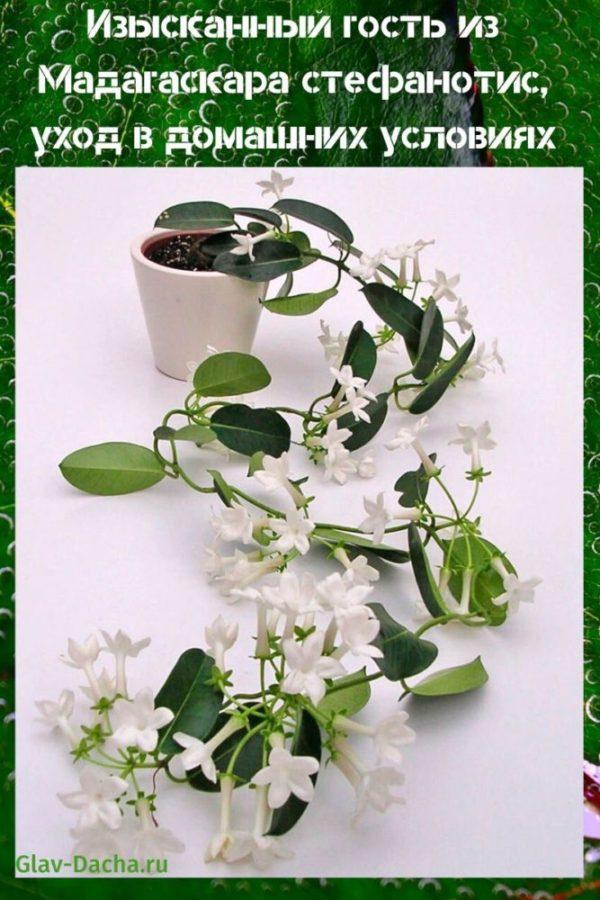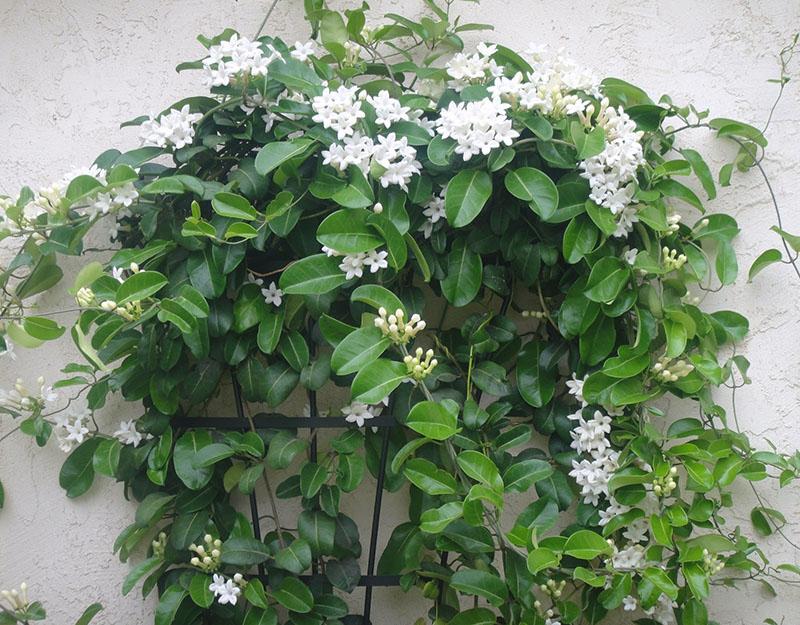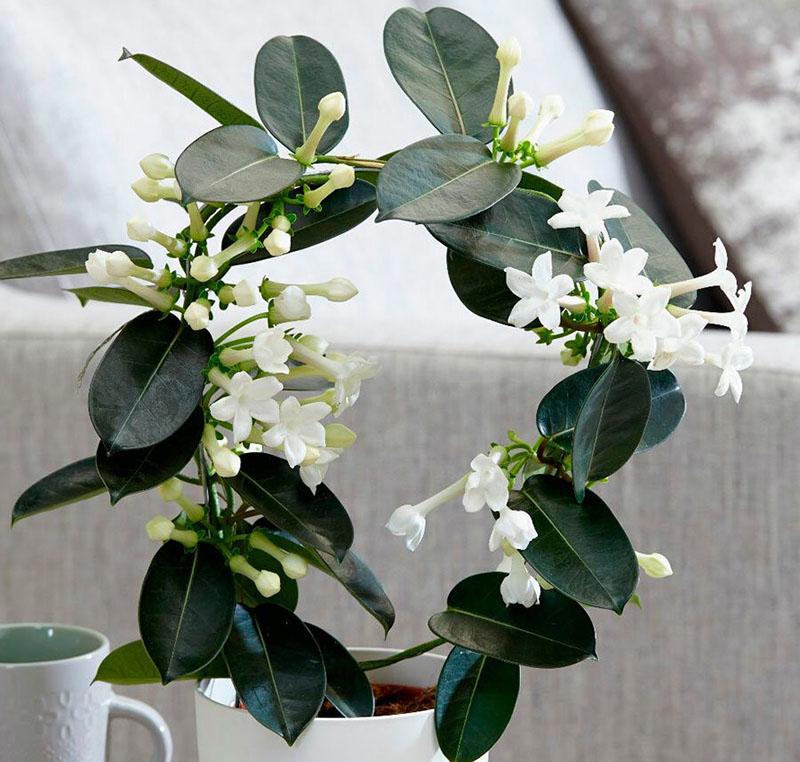Gourmet guest from Madagascar stephanotis, home care
 An evergreen liana with luxurious buds and a delicate aroma is called Stephanotis; caring for it at home requires special skills. Otherwise, the flower will lose its attractiveness and general admiration. Stephanostis was first discovered on the island of Madagascar. Its delicate buds exuded a delicate aroma reminiscent of jasmine. Today it can be found in Japan, China and Malaysia. In its natural environment, it grows up to 6 m in length, and at home, no more than 100 cm. Let's get to know an exquisite guest from the distant island of Madagascar.
An evergreen liana with luxurious buds and a delicate aroma is called Stephanotis; caring for it at home requires special skills. Otherwise, the flower will lose its attractiveness and general admiration. Stephanostis was first discovered on the island of Madagascar. Its delicate buds exuded a delicate aroma reminiscent of jasmine. Today it can be found in Japan, China and Malaysia. In its natural environment, it grows up to 6 m in length, and at home, no more than 100 cm. Let's get to know an exquisite guest from the distant island of Madagascar.
A detailed description of the culture, photos and types

The main shoot of stephanotis is decorated with leathery dark green foliage with miniature petioles. The edges of the plates are solid, pointed, and the warp is oval. The width of the leaf is up to 9 cm, the length is about 5 cm. Annually, from the beginning of March, funnel-shaped star-shaped buds appear among the greenery. The length of the petals is up to 4 cm, the diameter of the flower is 5-6 cm. The buds are collected in groups of 6-7 pieces.
Depending on the variety, the petals are painted in such tones:
- snow-white;
- cream;
- yellow;
- light purple.
 After flowering, elliptical fruits are formed from the buds. When they ripen, flying seeds come out. Outwardly, they resemble an ordinary dandelion.
After flowering, elliptical fruits are formed from the buds. When they ripen, flying seeds come out. Outwardly, they resemble an ordinary dandelion.
According to the literal translation, the word "stephanotis" means "a crown of pig's ears." And indeed, looking at the petals of the buds, one involuntarily imagines this very picture.
Stefanotis Floribunda
 The most popular type of indoor culture is Stephanotis Floribunda. From the outside, it looks like a regular climbing shrub. The leaf plates are located oppositely along the entire "trunk". They have a classic oval shape with a pointed tip. Plates are painted in deep green. The front part of the leaf is distinguished by a glossy sheen, which gives the culture a solid look. Large white buds are gracefully collected in inflorescences that resemble an open umbrella. Culture feels great in greenhouses, winter gardens and on the windowsills of residential buildings.
The most popular type of indoor culture is Stephanotis Floribunda. From the outside, it looks like a regular climbing shrub. The leaf plates are located oppositely along the entire "trunk". They have a classic oval shape with a pointed tip. Plates are painted in deep green. The front part of the leaf is distinguished by a glossy sheen, which gives the culture a solid look. Large white buds are gracefully collected in inflorescences that resemble an open umbrella. Culture feels great in greenhouses, winter gardens and on the windowsills of residential buildings.
Variegated Stephanotis
 The main difference between the culture is the unusual color of the foliage, located on thick and strong stems. White or yellow spots are visible on the plates. It is this "flaw" that makes the culture unique in its kind.
The main difference between the culture is the unusual color of the foliage, located on thick and strong stems. White or yellow spots are visible on the plates. It is this "flaw" that makes the culture unique in its kind.
Akuminata
 The plant belongs to the most whimsical indoor flowers from its family. The species is mainly grown by professional biologists in the territory of botanical gardens. A peculiarity of the culture is small cream-colored buds of an elongated shape.
The plant belongs to the most whimsical indoor flowers from its family. The species is mainly grown by professional biologists in the territory of botanical gardens. A peculiarity of the culture is small cream-colored buds of an elongated shape.
Madagascar jasmine stephanotis, home care
 Climbing plant fans all over the world enjoy growing this lovely plant. However, in order for it to successfully take root at home, it is necessary to choose the right container. Experts advise using pot made of ceramic... If you put Stephanotis in a plastic container, with its powerful root system, it can easily knock it to the floor. The size of the container is selected in accordance with the root system.In a pot that is too voluminous, the culture will develop for a long time and even stop blooming. In addition, there should be a drain hole at the bottom of the container.
Climbing plant fans all over the world enjoy growing this lovely plant. However, in order for it to successfully take root at home, it is necessary to choose the right container. Experts advise using pot made of ceramic... If you put Stephanotis in a plastic container, with its powerful root system, it can easily knock it to the floor. The size of the container is selected in accordance with the root system.In a pot that is too voluminous, the culture will develop for a long time and even stop blooming. In addition, there should be a drain hole at the bottom of the container.
Before planting, the container is thoroughly washed, after which it is kept in clean water for about 3 hours. This procedure helps to remove harmful substances that remain after processing the clay. Then the container is poured over with boiling water and wiped with a thick napkin.
After washing, the old container is treated with a hot soda solution.
Priming
 Competent home care for stephanotis begins with preparing the land. A slightly acidic substrate is best suited. You can buy it ready-made or prepare it yourself.
Competent home care for stephanotis begins with preparing the land. A slightly acidic substrate is best suited. You can buy it ready-made or prepare it yourself.
Components required:
- humus (3 hours);
- sand (2 hours);
- clay-soddy soil (1 hour);
- deciduous substrate (1 h).
In addition, brick chips or bone meal and pre-crushed moss are added to it. The prepared soil for stephanotis is disinfected so that pests do not develop in it. The procedure is performed in different ways. Let's consider several options.
Freezing soil
The substrate is poured into a cloth bag. Sent to the freezer for 7 days. Then they are removed and kept at room temperature for the same days. The procedure is then repeated. As a result, the cold destroys all pest clutches.
Oven roasting
An oven is used for business. Pour the substrate onto a baking sheet. Carefully leveled with a spatula to form a thin layer. Heat the oven to 90 ° C. The earth is warmed up for 30 minutes.
Steaming
The procedure takes approximately 1.5 hours. The soil is poured into a bag and heated over steam. To do this, boil water in a volumetric container. A metal grate is installed on the hole, on top of which the substrate is placed.
Immediately after the procedure, the soil is enriched with bacterial preparations.
Comfortable habitat
 As you know, plants are not very fond of drastic changes. Having adapted to the environment, they develop successfully. The stephanotis behaves in the same way. How to care for a culture in an enclosed space? You need to adhere to certain rules.
As you know, plants are not very fond of drastic changes. Having adapted to the environment, they develop successfully. The stephanotis behaves in the same way. How to care for a culture in an enclosed space? You need to adhere to certain rules.
First of all, it is placed on a windowsill with moderate sunlight. East or west windows will do. If the choice fell on the south side, then the glass is covered with a fabric screen or paper. Otherwise, the merciless rays of the sun will "paint" the plates with burns, which have a detrimental effect on the development of culture.
 Sometimes it happens that Stephanotis does not bloom. What should beginners of flora do in such cases? After all, the overseas liana is appreciated precisely for its luxurious buds.
Sometimes it happens that Stephanotis does not bloom. What should beginners of flora do in such cases? After all, the overseas liana is appreciated precisely for its luxurious buds.
Experts name several reasons:
- lack of lighting (the culture is located in the back of the dwelling or on the north window);
- too voluminous pot;
- poor feeding.
It seems that by eliminating these shortcomings, the plant will give the owner a wreath of exquisite buds. However, this is not always the case. Therefore, beginners are thinking about how to make Stephanotis bloom all 10 months of the year.
Experts advise:
- provide culture with full peace in autumn and winter;
- make sure that the container matches the size of the root system and completely envelops the earthen lump;
- regularly contribute fertilizersstimulating the appearance of buds.
 Unfortunately, even with abundant flowering, the leaves of Stephanotis turn yellow. What to do to save culture? First, you need to adhere to the culture transplant rules. If the procedure is carried out at the time of flowering, foliage loss is inevitable. In addition, stephanotis should not be moved from its "old" habitat or turned towards the light. Such actions cause stress in exotic jasmine, as a result of which foliage and buds turn yellow and fall off.
Unfortunately, even with abundant flowering, the leaves of Stephanotis turn yellow. What to do to save culture? First, you need to adhere to the culture transplant rules. If the procedure is carried out at the time of flowering, foliage loss is inevitable. In addition, stephanotis should not be moved from its "old" habitat or turned towards the light. Such actions cause stress in exotic jasmine, as a result of which foliage and buds turn yellow and fall off.
The optimum temperature for the comfortable development of the crop should be between 14 and 25 ° C.
Regular feeding
 The list of measures for caring for stephanotis at home includes fertilization. They stimulate the growth and ejection of buds. For the first time, chemicals are added to the soil immediately after the end of winter dormancy. Then the procedure is repeated 3 times a month.
The list of measures for caring for stephanotis at home includes fertilization. They stimulate the growth and ejection of buds. For the first time, chemicals are added to the soil immediately after the end of winter dormancy. Then the procedure is repeated 3 times a month.
You can use a liquid fertilizer for flowering houseplants, which is sold in specialty stores.
 When buds appear, the amount of nitrogenous substances is reduced. They are replaced with phosphorus and potassium preparations. The dose is determined based on the instructions for the chemical. Top dressing is applied throughout the warm season. They stop at the end of October, when the overseas guest prepares for the winter vacation.
When buds appear, the amount of nitrogenous substances is reduced. They are replaced with phosphorus and potassium preparations. The dose is determined based on the instructions for the chemical. Top dressing is applied throughout the warm season. They stop at the end of October, when the overseas guest prepares for the winter vacation.
Breeding secrets and transplant
 Depending on the age, the indoor culture needs a regular transplant. Adult specimens are transferred to a new pot once a year, and young ones (up to 2 years old) are transplanted every 6 months. Plants over five years old are left in the same pot. However, the top layer of the earth is carefully removed, replacing it with a fresh substrate.
Depending on the age, the indoor culture needs a regular transplant. Adult specimens are transferred to a new pot once a year, and young ones (up to 2 years old) are transplanted every 6 months. Plants over five years old are left in the same pot. However, the top layer of the earth is carefully removed, replacing it with a fresh substrate.
The transplant of Stephanotis is performed very carefully, following simple instructions:
- first, the earth is watered abundantly with water;
- when it softens, the plant is carefully dumped out of the pot;
- a drainage layer (pebbles, broken brick) is placed in a new treated container;
- pour fresh substrate to half the pot;
- place the plant;
- sprinkle with earth;
- compact;
- watered abundantly.
To give the culture strength, foliage is sprayed. During this period, the flower is not fed, since there are no buds on it. It is enough to water the plant several times with a mixture of water with a root stimulator.
Since the foliage secretes toxic sap, the transplant is carried out with rubber gloves.
Planned reproduction of Stephanotis is carried out in two ways: by cuttings and with the help of seeds. Let's consider the basic principles of both options.
Cuttings
 Tops are used as consumables, which have 3 or 4 sheet plates. The branch is placed in a glass container, where a root formation stimulator is poured. At this time, a soil mixture of peat and sand is prepared, which is poured into a pot. Make a funnel about 2 cm deep in the center and place a seedling in it. Cover with foil or a plastic cup with multiple holes. They are needed to bring in fresh air. In a month, the seedling will have roots. Now it is being transplanted into a pot.
Tops are used as consumables, which have 3 or 4 sheet plates. The branch is placed in a glass container, where a root formation stimulator is poured. At this time, a soil mixture of peat and sand is prepared, which is poured into a pot. Make a funnel about 2 cm deep in the center and place a seedling in it. Cover with foil or a plastic cup with multiple holes. They are needed to bring in fresh air. In a month, the seedling will have roots. Now it is being transplanted into a pot.
Reproduction of Stephanotis by cuttings is carried out in early spring. Thanks to this, the characteristics of the crop variety are preserved.
Sowing seeds
 Although the method does not always lead to success, still, flora fans use it. The planting material is treated with a solution of potassium permanganate. Then they are sown in a substrate made of sand and peat. The depth of the holes is about 1 cm. The crops are abundantly watered from a spray bottle, sprinkled with earth, covered with glass. The containers are taken to a room where the temperature is maintained at least 21 ° C. After 2 weeks, sprouts will appear, after which the glass is removed. When two true leaves are formed, the plant is planted in small pots. Watered abundantly and placed on a window on the east or west side.
Although the method does not always lead to success, still, flora fans use it. The planting material is treated with a solution of potassium permanganate. Then they are sown in a substrate made of sand and peat. The depth of the holes is about 1 cm. The crops are abundantly watered from a spray bottle, sprinkled with earth, covered with glass. The containers are taken to a room where the temperature is maintained at least 21 ° C. After 2 weeks, sprouts will appear, after which the glass is removed. When two true leaves are formed, the plant is planted in small pots. Watered abundantly and placed on a window on the east or west side.
To please stephanotis with its appearance, home care contains several principles that are important to adhere to. It includes pot selection, habitat, and quality substrate creation. Regular watering and feeding. If necessary, the culture is transplanted or propagated in an accessible way. As a result, a guest from Madagascar will "settle" for a long time in a cozy apartment or a country house of friendly people.